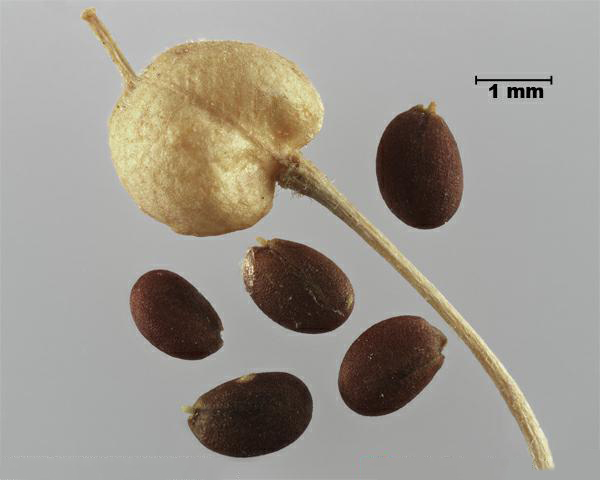Family
Brassicaceae
Common Name
Field peppergrass
Regulation
Secondary Noxious, Class 3 in the Canadian Weed Seeds Order, 2016 under the Seeds Act.
Distribution
Canadian: Occurs in AB, BC, NB, NF, NS, ON, PE and QC (Brouillet et al. 2016Footnote 1).
Worldwide: Native to parts of Europe and western parts of temperate Asia (USDA-ARS, 2016Footnote 2). Naturalized in eastern temperate Asia, Europe, Australia, New Zealand, North and South America (USDA-ARS 2016Footnote 2).
Duration of life cycle
Annual or Biennial
Seed or fruit type
Seed
Identification features
Size
- Seed length: 2.0 - 3.0 mm
- Seed width: 1.5 - 2.0 mm
- Seed thickness: 1.5 mm
Shape
- Seed oval, compressed, tapers at hilum end
Surface Texture
- Seed surface densely covered in small tubercles
Colour
- Seed dark reddish-brown
Other Features
- One end of seed is rounded and the other end is narrow with yellowish tissue over the hilum
- Pale line visible between the radicle and the cotyledons on the seed
Habitat and Crop Association
Cultivated fields, pastures, gardens, old fields, meadows, open-flats, forests, rocky slopes, roadsides and disturbed areas (FNA 1993+Footnote 3, Darbyshire 2003Footnote 4).
General Information
Field peppergrass is poisonous to livestock (Darbyshire 2003Footnote 4).
Similar species
Globe-pod hoary cress (Lepidium appelianum)
- Globe-pod hoary cress has a similar oval shape and roughened surface as field peppergrass.
- Globe-pod hoary cress (length: 2.0 - 2.5 mm; width: 1.3 - 1.8 mm) is generally smaller than field peppergrass, reddish rather than dark reddish-brown, the hilum area is rounded and the surface is not tuberculate.
Photos




Similar species


